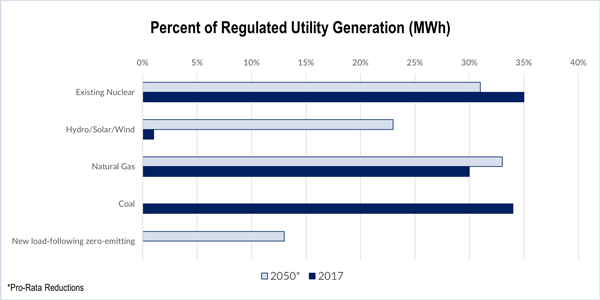By Rory D. Sweeney
Duke Energy last week announced an updated carbon-reduction plan that anticipates relying on natural gas and technology advancements to phase out coal-fired generation by 2050.
In a report on climate change to shareholders, the company said it plans to retire nine coal-fired plants, totaling 2,006 MW, by 2024. Between 2011 and 2017, it retired 47 units equaling 5,424 MW.
In the short term, gas-fired generation will pick up the slack. Duke projects natural gas generation will increase from about 30% of the company’s total generation today to 42% in 2030, while coal generation will decrease to 16%. Generation from wind, hydro and solar renewables will double to 10%.
2030 Goals
Duke says it has committed to spend $11 billion by 2026 to build new gas-fired, wind and solar generation with the goal of reducing carbon dioxide emissions 40% from 2005 levels by 2030. That would put companywide carbon dioxide emissions around 91.8 million pounds per year.
The goal would include reducing carbon intensity — pounds of carbon dioxide created per kilowatt-hour of production — by 45% compared to 2005 levels, equaling about 0.7 pounds/kWh. As of 2016, according to the company, it has already reduced its carbon dioxide emissions 29% and its carbon intensity 25% below 2005 levels.
Coal-free by 2050
To phase out coal by 2050, Duke anticipates generation from renewables more than doubling again to 23% and gas-fired generation falling back to 33%. It would also rely on 13% from currently nonexistent technology that has zero emissions and can vary its output to match demand. Potential candidates are nuclear that can vary its output (current technologies are inflexible), closed cycle biomass-fired facilities and combined cycle gas turbines (CCGTs) with carbon capture and storage.
“In the past 15 years, we’ve seen dramatic advancements in energy technology, including abundant natural gas due to hydraulic fracturing, and declining prices of solar and wind technology. Given this rapid pace of development, we fully expect technology innovations in the coming decades,” the report explained.
The report assumes that, including efficiency programs, load increases 0.45% each year. It also relies on natural gas prices remaining flat through 2028 and increasing 4% annually after that, along with 20-year license extensions for its 9,000 MW of nuclear generation. The estimates are based on limiting global warming to no more than a 2-degree Celsius increase and assume that all emissions sources throughout the world reduce by the same amount: 74% compared to 2005 levels.
100% Renewables Unrealistic
The report explains that renewables have diminishing returns because of lower capacity factors and sides with academics who — in a recent white-paper war — argued there are cheaper ways to achieve zero carbon dioxide emissions in the energy sector than switching completely to renewables.
“As the adoption of renewables grows to between 20 and 30% of total generation, the value of the resource begins to diminish due to extended periods of excess energy in the spring and fall and insufficient output during the winter months,” Duke said. “We do not believe 100% renewables can reliably deliver the power required by a modern economy. Similarly, we do not advocate for 100% natural gas or nuclear energy. An analysis published in the Proceedings of the National Academy of Science[s] concluded that a decarbonized energy system would very likely need other technologies besides renewables, including nuclear and carbon capture and sequestration.”
Another analysis concluded “that the high-renewables scenario was likely the most costly, while both the mixed scenario (renewables, nuclear and carbon capture on fossil) and the high-nuclear scenario would likely cost less,” Duke’s report said.




